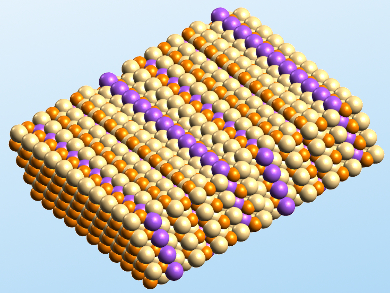Transition-metal pnictides (group 15 compounds) are potentially interesting electronic materials, forming superconductors, thermoelectric compounds, and layered structures. As a part of a study to identify new solid ion conductors, Tom Nilges and colleagues, Technical University Munich, Germany, explored the isostructural Zintl phases (polyanionic compounds) NaCd4P3 and NaCd4As3.
The researchers synthesized the compounds from the elements under an argon atmosphere, with CdI2 as a mineralizer. NaCd4P3 (pictured) forms platelike crystals with a metallic luster. This phosphide is a new member of the RbCdAs3 structure family, and it undergoes a reversible rhombohedral-to-monoclinic phase transition at 260 K, driven by secondary attractive interactions within the Cd-P polyanionic substructure. The low-temperature (monoclinic) polymorph has an incommensurate modulated structure, which was more pronounced for the phosphide than for the arsenide.
The thermoelectric properties of the phosphide are typical of an n-type semiconductor, while the arsenide is a semimetal. Quantum chemical calculations determined a band gap of 1.05 eV for the β phase of NaCd4P3 and 0.43 eV for β-NaCd4As3.
- Polymorphism in Zintl Phases ACd4Pn3: Modulated Structures of NaCd4Pn3 with Pn = P, As,
Carolin Grotz, Maximilian Baumgartner, Katharina M. Freitag, Franziska Baumer, Tom Nilges,
Inorg. Chem. 2016.
DOI: 10.1021/acs.inorgchem.6b01233




